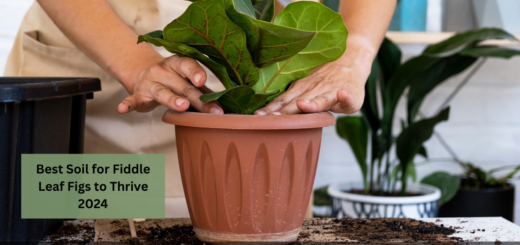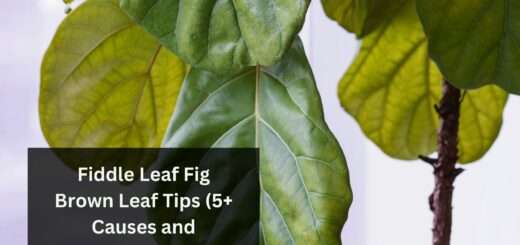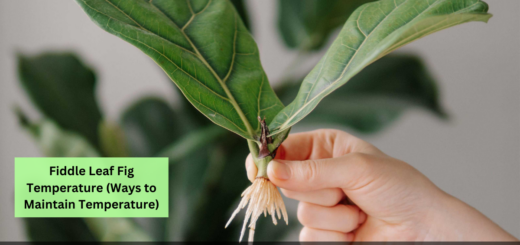Fiddle Leaf Fig Leaves Turning Yellow – Causes and Fixes
I was struggling with my Fiddle Leaf Fig plants. You know what? My Fiddle Leaf Fig leaves were turning yellow. I think many of you must have faced this problem. And now, I have found the solution. Eager to know what it is? Just be patient—you’ll get the answer.
This is one of the most common problems that gardeners face, but after reading this informative guide, all your problems will be solved. Let’s not waste time and see what I have discovered.
I’m here to share solutions for preventing Fiddle Leaf Fig leaves from turning yellow. I’ve explained all the various reasons and solutions to help your Fiddle Leaf Fig plants thrive. Without further ado, let’s save our Fiddle Leaf Fig plants.
This article will be discussing about the issue of the Fiddle Leaf Fig Leaves Turning Yellow.
Quick takeaways:
- the most common issue is the leaves turning yellow which dulls their appearance.
- The leaves turning yellow of any plant like mint indicates that the plant is under stress and unhealthy.
- The fiddle leaf figs’ yellowing leaves are due to various reasons including fewer nutrients in the soil, overwatering, underwatering, not getting enough sunlight, etc.
- Ficus lyrata which are commonly called fiddle leaf figs are beautiful plants known for their green leaves.
- These houseplants are one of the favorites among house planting gardeners.
Let’s look at all the causes thoroughly and fix the issues so that you can see the lush green leaves back on the fiddle-leaf fig plants.
Reasons behind the Fiddle Leaf Fig Leaves Turning Yellow
1. Overwatering
The common issue is the watering issue. When you overwater the fiddle leaf fig plants the leaves start to lose green color which is due to chlorophyll pigment. The overwatering is done when you water the plant and the soil is still moist and not drained well. The overwatering can bring fungal infections as well which can affect the roots and even the whole plant. Unwanted moisture around the plants can deteriorate the tissue and make the plant worthless to perform functions properly.

How to fix this?
The soil needs to be checked if it is dry and drained properly before watering the plants. Dont water if the soil is still moist. You can touch the top layer if 1-2 inches of soil is moist using your fingers. The soil if moldy needs to be discarded and start afresh with new clean soil having good drainage.
2. Underwatering
Watering issues include under-watering as well. The soil not being wet and you giving plants less water can make the fiddle leaf fig plants underwatered. There should be a good amount of water so that nutrients can be easily absorbed via water performed by roots. The soil staying dry for long will make the leaves fall and yellow. The leaves start to look lifeless and ultimately fall to the ground.
How to fix this?
Keep checking the soil if it’s dry to touch using a finger test. If the top two inches of soil feels dry, water the plant immediately. The dry soil can easily make the roots dry and the leaves yellow and even brittle. Spray the plant a few times a day if the heat is too much, keeping the leaves dry and spraying near the soil.
3. Less light
The fiddle leaf fig plants need indirect bright sunlight and should stay away from the string sunrays. The plants tend to be kept near the window that gets an ample amount of indirect sunlight. Good light is so important that without that fiddle leaf and fig plants can even die. The leaves get yellow colored and the older leaves start falling after which the young ones also start to fall.

How to fix this?
Keep the fiddle leaf fig plants near the south-facing window. The plant if outdoors needs to be given shade during the peak afternoon hours. The fiddle leaf fig plants need about 6-8 hours of sunlight which is indirect.
4. Low nutrients in the soil
The unfertilized fiddle leaf fig plants usually show yellowing of leaves as the less production of chlorophyll in the plants. The plant can get nutrient deficient if the space is not much and the roots are unable to absorb the nutrients which can be seen in potted plant cases and root rot situations. The roots get damaged due to fungus and are unable to perform their function properly.
How to fix this?
Provide the fiddle leaf fig plants with macronutrients through the fertilizer. The fertilization should be done using a 3-2-1 fertilizer
Repot the plant and change the size of the pot so that nutrients can be stored well in the soil in a good amount of space.
5. Poor soil drainage
Now you are already aware of the importance of drainage in the soil. The soil should have good drainage to keep the root rot-like problems at bay. Water standing for long in the soil can deteriorate the quality of soil and degrade the root’s ability to absorb the water. The leaves start to indicate this by yellowing.
How to fix this?
Use a soil mix that has good drainage, and good porosity for better aeration. The pot that you select also contains a lot of drainage holes.
6. Root rot
The soil staying soggy for a long is the main cause of root rot in the fiddle leaf fig plants. The soil if not clean and hygienic can also bring fungal growth which then spreads to the plant, the roots get a severe fungal infection and die leading to the death of the whole plant. The leaves turn yellow first due to low nutrients in plants and ultimately fall starting from the older leaves.
How to fix this?
Take the plants out of the pot or soil, and rub the extra dirt. See if there is root rot, remove or cut down those roots immediately to save the other roots. You also might need to report if the soil is affected as well.
7. Soil pH
The soil getting changed highly affects the fiddle leaf fig plants that prefer to stay happy in the neutral pH soil. The soil particularly when it gets acidic leads to the yellowing of leaves in them. The soil often gets acidic due to rainfall, having groundnuts in the soil mix or fertilizer, and using some chemicals like pesticides, fungicides, etc.
How to fix this?
Use a soil meter two to three times a week. You can check the soil pH regularly as well. Use a well-balanced or balancing fertilizer to ring back the normal soil ph level. If the soil is too acidic, use alkaline water to neutralize the acid in the soil.
8. Transplant shock
The transplantation shock in fiddle leaf fig plants happens when they are being reported. The change in conditions often leads to yellowing of the leaves as a result of the plant getting adapted. The sudden fluctuation in soil type, temperature, and moving, can lead to the transplantation shock in these plants. The drooping of leaves and yellowing of fiddle leaf fig leaves are usually witnessed in transplantation shock.
How to fix this?
Try to keep conditions normal and don’t bring too many changes around the plant. Do it at a slow speed. Be patient.
9. Pests
The yellowing of leaves of fiddle leaf fig plants can also be due to pest infestations. The pest makes the fiddle leaf fig plants weak, sucking on their energy, sap which is vital for the reactions. The insect’s infestation also can be the reason. The attack on the plants by pests and insects should be checked.
How to fix this?
Check for the signs of pests on the plant leaves and stems. Try to remove them manually or use organic pesticides or soap solutions.
10. Rootbound
The fiddle leaf plant roots can be root bound which is not letting roots absorb the nutrients properly. The post size being small can make the plant root-bound.
How to fix this?
Use a pot of a bigger size
Wrapping up the context
The fiddle plant doesn’t look good with those yellow leaves. We have tried our best to give every detail related to the causes of yellowing leaves of fiddle leaf fig plants. We also included the fixes that you should try to make the plant bring our green leaves. We hope this article was useful to you. Happy planting!


